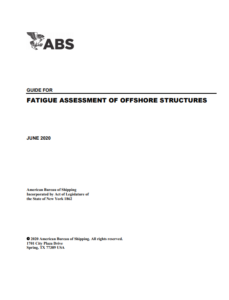ABS issued its updated “Fatigue Assessment of Offshore Structures”, which incorporates updated approaches for addressing fatigue including new S-N curves and guidance regarding fatigue strength based on fracture mechanics.
To begin with, it is explained that fatigue assessment is a process where the fatigue demand on a structural element is established and compared to the predicted fatigue strength of that element.
One way to categorize a fatigue assessment technique is to say that it is based on a direct calculation of fatigue damage or expected fatigue life. Three important methods of assessment are the Simplified Method, the Spectral Method and the Deterministic Method.
When considering fatigue inducing stress ranges, consideration is to be given to the possible influences of stress concentrations and how these alter the predicted values of the acting stress. The model used to analyze the structure may not adequately account for local conditions that will modify the stress range near the location of the structural detail subject to the fatigue assessment. In practice, this issue is resolved by modifying the results of the stress analysis by the application of a Stress Concentration Factor (SCF).
Overall, click on the report herebelow to get a better understanding of the fatigue assessment process.































































